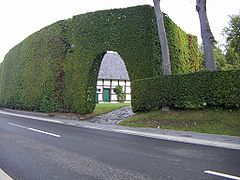Hedge
- For other meanings, see hedge.

A hedge is a line of closely spaced shrubs and bushes, planted and trained in such a way as to form a barrier or to mark the boundary of an area. Hedges, especially those used to separate a road from adjoining fields or one field from another, and of sufficient age to incorporate small trees, are also frequently known as hedgerows.
The Great Hedge of India was probably the largest example of a hedge used as a barrier. It was used to collect taxes.
Many hedgerows separating fields from lanes in England and the Low Countries are estimated to have been in existence for more than seven hundred years, and some are even older. Charles the Bald is recorded as complaining in 864, at a time when most official fortifications were constructed of wooden palisades, that some unauthorized men were constructing haies et fertés – tightly interwoven hedges of hawthorns.[1]
A hedge (Dutch: haag) gave its name to the city of The Hague in the Netherlands – Den Haag, or more formally 's Gravenhage in Dutch, meaning "the Count's hedge" (i.e. enclosure).
Hedgelaying

The maintenance and laying of hedges in such a way as to form an impenetrable fence for farm animals is a skilled art. In Britain there are many local hedgelaying traditions. Hedges are still being laid today as they are not only beautiful and functional but they also help wildlife and protect against soil erosion.
Prince Charles is the patron of the British Hedgelaying Society. He is also an active member, and on his Highgrove estate he lays and maintains hedges in the traditional way.
The hedge in gardening
Hedges, both clipped and unclipped, are often used for ornamental purposes in the layout of gardens. Typical woody plants for clipped hedges include privet, hawthorn, beech, yew, leyland cypress, hemlock, arborvitae, barberry, box, holly, oleander, lavender, etc. An early 20th century fashion was for tapestry hedges, using a mix of golden, green and glaucous dwarf conifers, or beech and copper beech. Unclipped hedges take up more space, generally at a premium in modern gardens, but compensate by flowering. Rosa multiflora is widely used as a dense hedge along median (central) strips of dual-carriageway roads, such as parkways in the United States. In mild climates, more exotic flowering hedges are formed, using Ceanothus, Hibiscus or Camellia.

Hedges of clipped trees forming avenues are a feature of 16th century Italian gardens such as the Boboli Gardens in Florence, and of formal French gardens in the manner of André Le Nôtre, e.g. at Versailles. The 'hedge on stilts' of clipped hornbeams at Hidcote Manor Garden, Gloucestershire, is famous and has sometimes been imitated.
Hedges below knee height are generally thought of as borders. Elaborately shaped and interlaced borders forming knot gardens or parterres were fashionable in Europe during the 16th and early 17th centuries. Generally they were appreciated from a raised position, either the windows of a house, or a terrace.
Clipped hedges above eye level may be laid out in the form of a labyrinth or garden maze. Few such mazes survived the change of fashion towards more naturalistic plantings in the 18th and 19th centuries, but many were replanted in 20th century restorations of older gardens. An example is behind the Governor's Palace, Colonial Williamsburg, Virginia.
Hedges and pruning can both be used to enhance a garden's privacy, as a buffer to visual pollution and to hide fences.
External links
Reference
- ^ Rouche, Michel, "Private life conquers state and society," in A History of Private Life vol I, Paul Veyne, editor, Harvard University Press 1987 ISBN 0-674-39974-9, page 428
